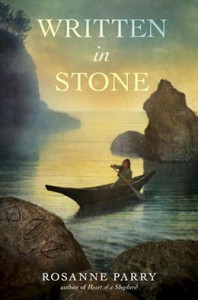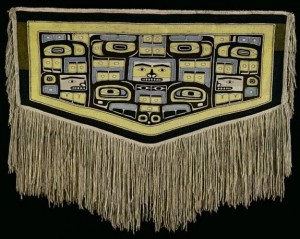 Debbie Reese who writes the Native Americans in Children’s Literature blog has posted a review of Written in Stone and invited a conversation about the concerns she raised about the book. I’ve been chatting with her in the comment section of her blog. If you’d like to see that conversation the link to her blog is highlighted above. I’m also putting my comments here for easy reference to teachers and librarians who may have questions about the material in the book. I have been a teacher myself. I really love talking to teachers and librarians so if you have questions about the story or about using this book in your class, please join the conversation.
Debbie Reese who writes the Native Americans in Children’s Literature blog has posted a review of Written in Stone and invited a conversation about the concerns she raised about the book. I’ve been chatting with her in the comment section of her blog. If you’d like to see that conversation the link to her blog is highlighted above. I’m also putting my comments here for easy reference to teachers and librarians who may have questions about the material in the book. I have been a teacher myself. I really love talking to teachers and librarians so if you have questions about the story or about using this book in your class, please join the conversation. I was happy to see both Debbie and Beverly Slapin comment on the controversy surrounding the 1999 Makah whale hunt. It was big news in the region and I’m glad to hear that the news made the national stage as well. The best information on how hunts are conducted is found here on the Makah website.
http://makah.com/makah-tribal-info/whaling/ There is much additional information to be found at the Makah Cultural Research Center in Neah Bay.
The resumption of whaling by the Makah encountered some vociferous opposition, most notably by the Sea Shepherd Society, but it also found support from a number of places. The International Whaling Commission verified that the gray whale is no longer an endangered species. There were marine safety issues to work out with local agencies. The hunt took place near a very busy international shipping lane, so that called for some communication and planning. Those negotiations were lengthy and complex but it’s not my impression that they were acrimonious. Unfortunately the peaceful working out of details does not make for exciting news, so I think the national outlets in particular paid attention to controversy more than cooperation.

I heard the Chairman of the Makah Whaling commission speak in Portland about the day of the hunt shortly after its completion. He said that on the morning of the hunt, the media was not present when the whalers set out and arrived only after the whale had already been brought in. The helicopters and cameras did show up eventually and the atmosphere on the beach got a bit chaotic, but there was a brief window of time when the Makah were (not completely but nearly) alone with their whale, and that time meant a great deal to them. Cultural renewal is the phrase the chairman used to describe what that moment meant to the tribe.
That is the moment I wanted for Pearl and her great-granddaughter. The reader can deduce from the news helicopter chop that the moment of peace will be brief but it’s the prerogative of the novelist to pick the focus of a scene and I wanted to end with that one moment of connection for Pearl’s family and their whale.
Absolutely true that the activist that Pearl grew up to be would have been in the thick of the work of resuming the treaty right to hunt whales. In fact when I first thought about writing this story I wanted to write about the resumption of whaling. Self-determination of natural resources is a piece of the civil rights story that seldom gets told. It’s a rich history and one I’d love to see in books for kids.
Ahem! you publishing professionals who have said in my hearing that there’s a need for more middle grade non-fiction, this is the perfect topic for a non-fiction series! It involves geography, history, a variety of Native and Non-native cultures, biology, chemistry, climate change, economics, international trade. Think of the possibilities for critical thinking and curriculum connections!
Back to the topic at hand

I left the whaling controversy out of Written in Stone for several reasons. Most of all I wanted to keep the focus on Pearl as a teenager in the 1920s and leave the 1999 whale hunt to serve as a frame and show that although the Makah lost whaling in the 1920s, it was not lost to them forever. It also shows that the Makah have not vanished nor maintained an Amish-like distance from the things of modern life, but continue to live and thrive in the same place they’ve always lived.
As I researched the whale hunt, the piece of it that really interested me was that the Makah, who had organized their culture for centuries around whale hunting, had to gave it up when the whale populations plummeted in the Pacific as a result of industrial whaling. That cultural survival piece of how to go on being the people that you are when something that so defined you is gone. That’s interesting to me personally and I think it’s something that people from a wide variety of cultures can relate to.
It’s true that I’m writing as an outsider to the Makah experience. A fiction writer is always writing outside of her experience. However, the Irish have long suffered the suppression of their culture, language, music, literature, and dance. And I know how I feel about playing a jig or hornpipe on my violin that’s hundreds of years old or dancing a set from my father’s county in Ireland; it’s an avenue of insight for me. Many people have an experience of cultural loss in coming to this country and although it is not the same experience it does make the story more accessible to the reader. So I chose to focus on the cultural survival aspect of this story rather than the resumption of whaling.
I also felt that a contemporary story about the Makah whaling experience would be better told by a whaler or other member of the tribe. I’d much prefer to use my book, imperfect instrument that it is, to nudge local writers in the direction of writing and publishing. In fact I’m happy to hear you’ll be in Washington. I’ve been developing the position of Youth Outreach Coordinator in our local SCBWI, in part, for the purpose of fostering a more diverse generation writers. Perhaps that’s an area where we could work together. One of the benefits of having a book published at a large publishing house is that it can attract attention to an issue. There is still so little in print about tribes of the northwest, and my hope is that if this book does well enough, then other publishers will see the potential for more books set among these tribes and addressing these vital issues–a need that could be filled by local writers.
I’ll stop here for today but later this week I’ll get to the pirates and indians bit that Debbie asked about on her blog post because, yes, there is a story about that!
Below are maps of Neah Bay in case you are not familiar with the Olympic Peninsula, and a picture of the other thing the Makah are famous for–an excellent halibut fishery.
 Debbie Reese who writes the Native Americans in Children’s Literature blog has posted a review of Written in Stone and invited a conversation about the concerns she raised about the book. I’ve been chatting with her in the comment section of her blog. If you’d like to see that conversation the link to her blog is highlighted above. I’m also putting my comments here for easy reference to teachers and librarians who may have questions about the material in the book. I have been a teacher myself. I really love talking to teachers and librarians so if you have questions about the story or about using this book in your class, please join the conversation.
Debbie Reese who writes the Native Americans in Children’s Literature blog has posted a review of Written in Stone and invited a conversation about the concerns she raised about the book. I’ve been chatting with her in the comment section of her blog. If you’d like to see that conversation the link to her blog is highlighted above. I’m also putting my comments here for easy reference to teachers and librarians who may have questions about the material in the book. I have been a teacher myself. I really love talking to teachers and librarians so if you have questions about the story or about using this book in your class, please join the conversation. 







 1. Acknowledge the soldier’s absence and encourage communication. A simple note or email to the family as soon as you learn of a deployment expressing your support and willingness to help sets you up for success over the coming months.
1. Acknowledge the soldier’s absence and encourage communication. A simple note or email to the family as soon as you learn of a deployment expressing your support and willingness to help sets you up for success over the coming months.